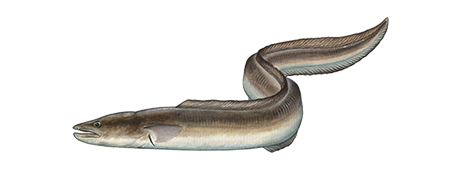Conger

A conger's great strength, sharp teeth, ability to swim backward, and propensity for remaining in or near cover make it a formidable foe.
HOW TO IDENTIFY A CONGER
The conger is a large eel known to reach a maximum length of 9 ft and a weight of 143 lbs. It is easily distinguished from the moray eel by the presence of pectoral fins, which the moray lacks. It also has a longer snout, its upper jaw is slightly longer than its lower jaw, the head is narrower in appearance, and the dorsal fin does not extend quite as far forward as in the moray.
WHERE TO CATCH CONGER
The conger is native to the eastern Atlantic; Norway and Iceland to Senegal including the Mediterranean and western Black Sea. It can also be found in the western Atlantic from Nova Scotia to North Florida but it is most plentiful from Cape Cod, Massachusetts to Cape Hatteras, North Carolina. They inhabit relatively shallow waters in the vicinity of cover material such as rocks, reefs, pier pilings, and especially shipwrecks or other submerged objects suitable as hiding places. The following list includes additional details on where to catch this fish:
BAYS DEEP SHORE WATER
JETTIES AND BREAKWATERS NIGHT FISHING
REEFS, WRECKS, AND SHOALS COASTAL WATERS
INLETS AND OUTLETS MAN-MADE STRUCTURES
PIERS, DOCKS AND PILINGS ROCKY SEA FLOOR
HOW TO CATCH CONGER
Anglers often target congers with stout tackle and strong lines, which are needed to pull larger fish from their cover once hooked. Methods include still fishing using live fish, squid, crabs or cut baits. Because it remains in sheltered places, it is almost exclusively an anglers’ fish since it is highly unlikely to be taken in a net. They should be considered dangerous when boated or speared as their teeth are strong and sharp. Congers are considered an excellent food fish but are not a popular table fare in the United States. The meat is known to be very delicate and flaky. The following are fishing methods used to catch this fish:
DRIFT FISHING STILL FISHING
CONGER LURES, TACKLE & BAIT
The following are lures, tackle or bait that can be used to catch this fish:
CLAMS CUT BAIT SQUID
CRABS SALTWATER LIVE BAIT